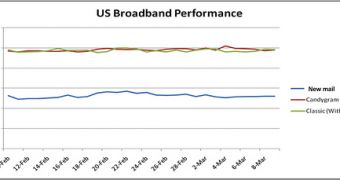The revamped Yahoo Mail, which has been in beta so far, is being rolled out to everyone. It's a major update, packed full of new features and improvements. Just as interesting as the new app itself is what Yahoo has done behind the scenes, to ensure that the new Yahoo Mail is faster than ever before.
"Six months ago we started something big with the launch of Yahoo! Mail Beta. Since then a lot has happened. Millions of users have opted in, dozens of improvements have been released and thousands of issues have been reported (and fixed!)," Mike Curtis, engineering lead for Yahoo Mail and Messenger, wrote.
"The main goal for the new Yahoo! Mail has always been speed and this new version is twice as fast as any of our former products. A huge amount of work has gone into making that a reality," he added.
The site itself is built using what has long been the standard toolkit for any web app, HTML, CSS and JavaScript. Nothing too spectacular, but going the tried and tested path is often the best way.
That's not to say that the new Yahoo Mail isn't modern, far from it, it uses CSS3 to create the graphical elements, eliminating much of the need for image files.
"Instead of using images to create rounded corner effects, we round the corners with CSS3. The product gracefully degrades on browsers that don’t support CSS3 by simply not showing rounded corners," Yahoo explained.
For the JavaScript part, Yahoo used its own YUI 3 libraries. The open source Yahoo User Interface libraries are used by the company for most of its sites, including the home page. However, the Mail team worked with the YUI team to optimize the framework too.
By going this route, Yahoo was able to reduce page size by 35 percent, a big improvement that should be visible by all users.
A smaller page is not all, Yahoo is also working on making sure the data gets to the users' computers as fast as possible, and it makes use of its cloud infrastructure around the world for this.
The HTTP proxy network that Yahoo employees determines where the closest data center is to a user's location and sends the necessary data over its own connections to the closest servers.
These are only the most obvious ways Yahoo has worked to make things faster, many improvements are at the infrastructure and underlying application level, for example with asynchronous JavaScript file downloads.

 14 DAY TRIAL //
14 DAY TRIAL //